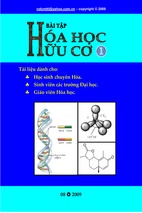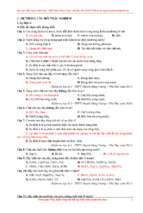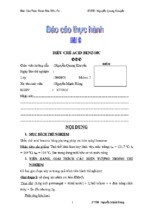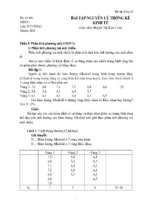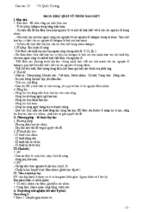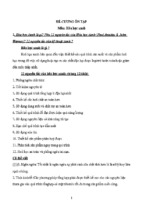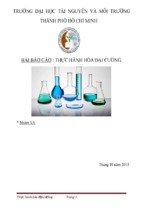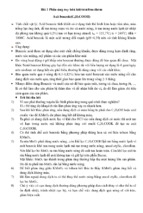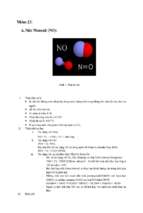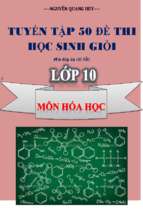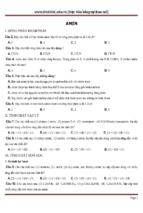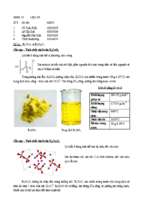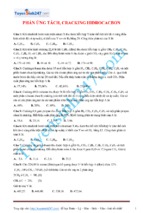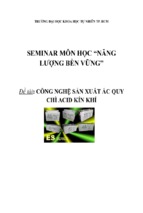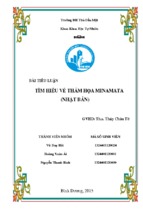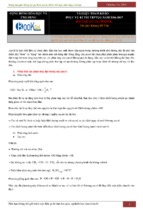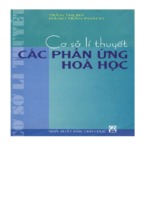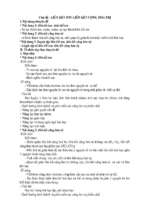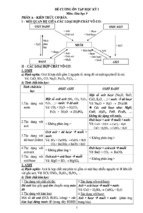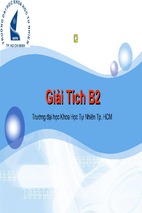Foundations of College Chemistry, 13 Edition - Morris Hein, Susan Arena
This online teaching and learning environment
integrates the entire digital textbook with the
most effective instructor and student resources
WR�ÀW�HYHU\�OHDUQLQJ�VW\OH�
With WileyPLUS:
Students achieve concept
mastery in a rich,
structured environment
that’s available 24/7
Instructors personalize and manage
their course more effectively with
assessment, assignments, grade
tracking, and more
manage time better
�study smarter
save money
From multiple study paths, to self-assessment, to a wealth of interactive
visual and audio resources, WileyPLUS gives you everything you need to
personalize the teaching and learning experience.
» F i n d o u t h ow t o M A K E I T YO U R S »
www.wileyplus.com
ALL THE HELP, RESOURCES, AND PERSONAL SUPPORT
YOU AND YOUR STUDENTS NEED!
2-Minute Tutorials and all
of the resources you & your
students need to get started
www.wileyplus.com/firstday
Student support from an
experienced student user
Ask your local representative
for details!
Collaborate with your colleagues,
find a mentor, attend virtual and live
events, and view resources
www.WhereFacultyConnect.com
Pre-loaded, ready-to-use
assignments and presentations
www.wiley.com/college/quickstart
Technical Support 24/7
FAQs, online chat,
and phone support
www.wileyplus.com/support
Your WileyPLUS
Account Manager
Training and implementation support
www.wileyplus.com/accountmanager
MAKE IT YOURS!
FOUNDATIONS OF
COLLEGE CHEMISTRY
This page intentionally left blank
FOUNDATIONS OF
COLLEGE CHEMISTRY
Thirteenth Edition
Morris Hein
Mount San Antonio College
Susan Arena
University of Illinois, Urbana-Champaign
John Wiley & Sons, Inc
VP & Publisher: Kaye Pace
Associate Publisher: Petra Recter
Acquisition Editor: Nicholas Ferrari
Project Editor: Jennifer Yee
Marketing Manager: Kristine Ruff
Production Manager: Dorothy Sinclair
Senior Production Editor: Sandra Dumas
Art Director: Jeofrey Vita
Designer: Amy Rosen
Senior Media Editor: Thomas Kulesa
Media Editor: Marc Wezdecki
Senior Illustration Editor: Anna Melhorn
Photo Department Manager: Hilary Newman
Photo Editor: Elinor Wagner
Production Management Services: Ingrao Associates
This book was typeset in 10/12 Minister Light at Preparé and printed and bound by R. R. Donnelley/Jefferson
City. The cover was printed by R. R. Donnelley/Jefferson City.
The paper in this book was manufactured by a mill whose forest management programs include
sustained yield—harvesting of its timberlands. Sustained yield harvesting principles ensure that the number of trees cut each year does not exceed the amount of new growth.
This book is printed on acid free paper. q
Copyright © 2011, 2007, 2004, 2000 by John Wiley & Sons, Inc. All rights reserved. No part of this
publication may be reproduced, stored in a retrieval system or transmitted in any form or by any means,
electronic, mechanical, photocopying recording, scanning or otherwise, except as permitted under
Sections 107 or 108 of the 1976 United States Copyright Act, without either the prior written permission
of the Publisher or authorization through payment of the appropriate per-copy fee to the Copyright
Clearance Center, 222 Rosewood Drive, Danvers, MA 01923, (978) 750-8400, fax (978) 646-8600.
Requests to the Publisher for permission should be addressed to the Permissions Department, John
Wiley & Sons, Inc., 111 River Street, Hoboken, NJ 07030-5774, (201) 748-6011, fax (201) 748-6008.
Evaluation copies are provided to qualified academics and professionals for review purposes only, for use
in their courses during the next academic year. These copies are licensed and may not be sold or transferred to a third party. Upon completion of the review period, please return the evaluation copy to Wiley.
Return instructions and a free of charge return shipping label are available at
www.wiley.com/go/returnlabel. Outside of the United States, please contact your local representative.
ISBN-13 978-0470-46061-0
ISBN-13 978-0470-55422-7
Printed in the United States of America
10 9 8 7 6 5 4 3 2 1
For Edna Ruth Hein
My wife, partner in life, and best friend for over
sixty-four years, who typed the manuscript for the
first edition of this textbook. Edna was sweet,
devoted, and a beautiful woman both inside and
outside. To know her was to love her.
M. H.
This page intentionally left blank
ABOUT THE AUTHORS
Morris Hein is professor emeritus of chemistry at Mt. San Antonio College, where
he regularly taught the preparatory chemistry course and organic chemistry. He is the
original author of Foundations of College Chemistry and his name has become synonymous with clarity, meticulous accuracy, and a step-by-step approach that students can
follow. Over the years, more than three million students have learned chemistry using
a text by Morris Hein. In addition to Foundations of College Chemistry, Twelfth Edition,
he is co-author of Introduction to General, Organic, and Biochemistry, Eighth Edition,
and Introduction to Organic and Biochemistry. He is also co-author of Foundations of
Chemistry in the Laboratory, Twelfth Edition, and Introduction to General, Organic and
Biochemistry in the Laboratory, Eighth Edition.
Susan Arena earned a BS and MA in Chemistry at California State UniversityFullerton. She has taught science and mathematics at all levels, including middle
school, high school, community college, and university. At the University of Illinois she
developed a program for increasing the retention of minorities and women in science
and engineering. This program focused on using active learning and peer teaching to
encourage students to excel in the sciences. She has coordinated and led workshops
and progrms for science teachers from elementary through college levels that encourage and support active learning and creative science teaching techniques. For several
years she was director of an Institute for Chemical Education (ICE) field center in
Southern California. Susan enjoys reading, knitting, traveling, classic cars, and gardening in her spare time when she is not playing with her grandchildren.
ix
This page intentionally left blank
P R E FA C E
This new Thirteenth Edition of Foundations of College Chemistry presents chemistry as
a modern, vital subject and is designed to make introductory chemistry accessible to
all beginning students. The central focus is the same as it has been from the first edition: to make chemistry interesting and understandable to students and teach them
the problem-solving skills they will need. In preparing this new edition, we considered
the comments and suggestions of students and instructors to design a revision that
builds on the strengths of previous editions. We have especially tried to relate chemistry to the real lives of our students as we develop the principles that form the foundation for the further study of chemistry, and to provide them with problem-solving
skills and practice needed in their future studies.
Course Options Foundations of College Chemistry, 13th Edition, is intended for stu-
dents who have never taken a chemistry course or those who have had a significant
interruption in their studies but plan to continue with the general chemistry sequence.
Since its inception this book has helped define the preparatory chemistry course and
has since developed a much wider audience. In addition to preparatory chemistry, our
text is used extensively in one-semester general purpose courses (such as those for
applied health fields) and in courses for nonscience majors.
Alternate Editions For the convenience of instructors and to accommodate the various lengths of academic terms, two versions of this book are available. Foundations
of College Chemistry, 13th Edition, includes 20 chapters and is our main text. Foundations of College Chemistry, Alternate 13th Edition, provides a shorter, 17-chapter
text in paperback with the same material, but without the nuclear, organic, and biochemistry chapters.
Development of Problem-Solving Skills
We all want our students to develop real skills in solving problems. We believe that a
key to the success of this text is the fact that our problem-solving approach works for
students. It is a step-by-step process that teaches the use of units and shows the change
from one unit to the next. We have added a new section (4.5) in order to emphasize
the general process needed to solve problems. We have then used this problem-solving
approach in our examples throughout the text to encourage students to think their way
through each problem. In this edition we continue to use examples to incorporate fundamental mathematical skills, scientific notation, and significant figures. We have
added Problem-Solving Strategy boxes in the text to highlight the steps needed to solve
chemistry problems. Painstaking care has been taken to show each step in the probg
p
Problem-Solving Strategy for Stoichiometry Problems
Use a balanced equation.
1. Determine the number of moles of starting substance.
Identify the starting substance from the data given in the problem statement.
Convert the quantity of the starting substance to moles, if it is not already done:
moles = (grams) a
1 mole
b
molar mass
2. Determine the mole ratio of the desired substance to the starting
substance.
The number of moles of each substance in the balanced equation is indicated by
the coefficient in front of each substance. Use these coefficients to set up the
mole ratio:
g
Practice 11.3
The formula for sodium oxide is Na2O. Predict the formula for
(a) sodium sulfide
(b) rubidium oxide
Practice 11.4
The formula for barium phosphide is Ba3P2 . Predict the formula for
(a) magnesium nitride
(b) barium arsenide
Practice Problems
moles of desired substance in the equation
Problem-Solving Strategy
xi
xii
PREFACE
lem-solving process and to use these steps in solving example problems. We continue
to use four significant figures for atomic and molar masses for consistency and for
rounding off answers appropriately. We have been meticulous in providing answers,
correctly rounded, for students who have difficulty with mathematics.
Fostering Student Skills Attitude plays a critical role in problem solving. We encourage students to learn that a systematic approach to solving problems is better than simple memorization. Throughout the book we emphasize the use of our approach to
problem solving to encourage students to think through each problem. Once we have
laid the foundations of concepts, we highlight the steps so students can locate them
easily. Important rules and equations are highlighted for emphasis and ready reference.
Student Practice Practice problems follow the examples in the text, with answers
provided at the end of the chapter. The end of each chapter begins with a Chapter
Review and Review Questions section, which help students review key terms and concepts, as well as material presented in tables and figures. This is followed by Paired Exercises, covering concepts and numerical exercises, where two similar exercises are
presented side by side. The final section, Additional Exercises, includes further practice problems presented in a more random order. In our new edition we have changed
a significant number of exercises per chapter, and added new “Challenge Exercises.”
Answers for selected exercises appear in Appendix VI, and answers for Putting It
Together review exercises appear in Appendix VII.
Emphasis on Real-World Aspects
We continue to emphasize the less theoretical aspects of chemistry early in the book,
leaving the more abstract theory for later. This sequence seems especially appropriate
in a course where students are encountering chemistry for the very first time. Atoms,
molecules, and reactions are all an integral part of the chemical nature of matter. A
sound understanding of these topics allows the student to develop a basic understanding of chemical properties and vocabulary.
Chapters 1 through 3 present the basic mathematics and the language of chemistry,
including an explanation of the metric system and significant figures. In Chapter 4 we
present chemical properties—the ability of a substance to form new substances. Then,
in Chapter 5, students encounter the history and language of basic atomic theory.
We continue to present new material at a level appropriate for the beginning student by emphasizing nomenclature, composition of compounds, and reactions in
Chapters 6 through 9 before moving into the details of modern atomic theory. Some
applications of the Periodic Table are shown in early chapters and discussed in detail
in Chapters 10 and 11. Students gain confidence in their own ability to identify and
work with chemicals in the laboratory before tackling the molecular models of matter. As practicing chemists we have little difficulty connecting molecular models and
chemical properties. Students, especially those with no prior chemistry background,
may not share this ability to connect the molecular models and the macroscopic properties of matter. Those instructors who feel it is essential to teach atomic theory and
bonding early in the course can cover Chapters 10 and 11 immediately following
Chapter 5.
New to This Edition
In this Thirteenth Edition we have tried to build on the strengths of the previous editions. We have worked to update the art and add more macro to molecular figures to
help students clarify concepts visually. We continually strive to keep the material at the
PREFACE
same level so students can easily read and use the text to learn chemistry. Some specific changes in the text are highlighted below:
• Chapter 2 highlights the use of dimensional analysis through the use of Solution
Maps. These maps are used throughout the text in examples when conversion of
units is required.
• Chapter 4 contains a new section which focuses on the process of solving problems. A new general strategy using the steps of read, plan, set-up, calculate, and
check is used in examples throughout the text.
• Examples have been reformatted to use the new problem solving process and to
make use of Solution Maps to convert units.
• Rules boxes have been added throughout the text to highlight the rules for such
chemistry concepts as significant figures, and scientific notation.
• Molecular art: Learning chemistry requires the ability to connect the macroscopic
world of everyday life to the microscopic world of atoms and molecules. In this edition
we have added molecular art to macroscopic pictures to emphasize this connection.
• Chapter Reviews have been reformatted to include key terms and to review each
section in a bulleted format similar to what a student might use to review the material. We have included summary art from the chapter in this section to aid visual
learners. Review Questions are included in the Chapter Reviews to encourage students
to restate concepts from the chapter and to apply Tables and Figures to new situations.
• Design and Illustration Program: This edition has a fresh new design, enhanced
by an updated art and photo program. New photos appear throughout.
• Problem Solving: Because the development of problem-solving skills is essential
to learning chemistry, in this new design the sections on problem solving are highlighted throughout for easy student reference.
• Math Skills Learning Aids: A Review of Mathematics is provided as Appendix I for students who need assistance.
• Chemistry in Action sections, a number are new to this edition, show the impact of
chemistry in a variety of practical applications. These essays cover a range of relevant topics and introduce experimental information on new chemical discoveries and applications.
• Important statements, equations, and laws are highlighted for emphasis. A Glossary is provided to help students review key terms, with section numbers given for
each term to guide the student to the contextual definition. The margins of the
glossary pages are color tinted to provide ready access. Glossary terms are also printed in bold type in the text.
• End of chapter exercises, provide practice and review of the chapter material.
Paired exercises present two parallel exercises, side by side, so the student can solve
one problem, check the answer in Appendix VI, and use the same problem-solving
skills with the second exercise. Additional exercises are provided at the end of most
chapters, arranged in random order, to encourage students to review the chapter
material. Answers to selected exercises are given in Appendix VI.
• Putting It Together review sections appear after every 2 to 4 chapters and include
additional conceptually oriented exercises for effective self-review. These review
sections are printed on colored pages for easy reference and provide students with
a helpful summary of the preceding material. Answers to Putting It Together
review sections are given in Appendix VII.
• Directions on using a calculator to solve problems are given in Appendix II, Using
a Scientific Calculator.
• Units of measurement are shown in table format in Appendix IV and in the
endpapers.
xiii
xiv
PREFACE
Learning Aids
To help the beginning student gain the confidence necessary to master technical
material, we have refined and enhanced a series of learning aids:
• Important terms are set off in bold type where they are defined, and are printed in
black in the margin. Most glossary terms are also defined in the glossary.
• Worked examples show students the how of problem solving using Problem-Solving
Strategies and Solution Maps before they are asked to tackle problems on their own.
• Practice problems permit immediate reinforcement of a skill shown in the example problems. Answers are provided at the end of the chapter to encourage students to check their problem solving immediately.
• Marginal notations help students understand basic concepts and problem-solving techniques. These are printed in green ink to clearly distinguish them from text
and vocabulary terms.
Learning Aids: Math Skills For students who may need help with the mathematical aspects of chemistry, the following learning aids are available:
• A Review of Mathematics, covering the basic functions, is provided in Appendix I.
• Math Survival Guide: Tips and Tricks for Science Students, 2nd Edition, by Jeffrey R. Appling and Jean C. Richardson, a brief paperback summary of basic skills that
can be packaged with the text, provides an excellent resource for students who need
help with the mathematical aspects of chemistry.
Supplements Package and Companion Web Site
For the Student Study Guide by Rachael Henriques Porter is a self-study guide for
students. For each chapter, the Study Guide includes a self-evaluation section with
student exercises, a summary of chapter concepts, one or more “challenge problems,”
and answers and solutions to all Study Guide exercises.
Solutions Manual by Morris Hein, Susan Arena, and Kathy Mitchell includes
answers and solutions to all end-of-chapter questions and exercises.
Math Survival Guide: Tips and Tricks for Science Students, 2nd Edition, a
paperback summary of basic skills with practice exercises in every chapter.
Foundations of Chemistry in the Laboratory, 13th Edition, by Morris Hein,
Judith N. Peisen and Robert L. Miner includes 28 experiments for a laboratory program that may accompany the lecture course. Featuring updated information on waste
disposal and emphasizing safe laboratory procedures, the lab manual also includes
study aids and exercises.
For the Instructor Test Bank, by Anthony Stellato. Includes chapter tests with
additional test questions, and answers to all test questions.
Computerized Test Bank. The test bank contains true-false, multiple-choice, and
open-ended questions, and is available in two formats.
WileyPLUS is an online teaching and learning environment that integrates the entire digital textbook with the most effective instructor and student resources to fit
every learning style. It contains a variety of rich repositories of assessment, much of
which are algorithmic. The diverse problem types are designed to enable and support
problem-solving skills development and conceptual understanding. WileyPLUS offers
three unique repositories of questions which provide breadth, depth and flexibility in
instructional and assessment content.
• End of chapter questions are available, featuring immediate answer feedback. A
subset of these end of chapter questions are linked to Guided Online Tutorials
which are stepped out problem-solving tutorials that walk the student through the
PREFACE
problem, offering individualized feedback at each step. The testbank is also offered
as assignable questions for homework. In addition to the test bank and end of
chapter questions, WileyPLUS offers an assignment type called CATALYST, which
are prebuilt concept mastery assignments, organized by topic and concept, allowing for iterative drill and skill practice. For more information on CATALYST,
visit: www.wiley.com/college/catalyst.
For Students WileyPLUS addresses different learning styles, different levels of proficiency, and different levels of preparation—each of your students is unique. WileyPLUS empowers them to take advantage of their individual strengths:
• Students receive timely access to resources that address their demonstrated needs,
and get immediate feedback and remediation when needed.
• Integrated, multimedia resources—including audio and visual exhibits, demonstration problems, and much more—provide multiple study-paths to fit each student’s learning preferences and encourage more active learning.
• WileyPLUS includes many opportunities for self-assessment linked to the relevant
portions of the text. Students can take control of their own learning and practice
until they master the material.
For Instructors WileyPLUS empowers you with the tools and resources you need to
make your teaching even more effective:
• You can customize your classroom presentation with a wealth of resources and functionality from PowerPoint slides to a database of rich visuals. You can even add
your own materials to your WileyPLUS course.
• With WileyPLUS you can identify those students who are falling behind and intervene accordingly, without having to wait for them to come to office hours.
• WileyPLUS simplifies and automates such tasks as student performance assessment,
marking assignments, scoring student work, keeping grades, and more.
WileyPLUS can be used in conjunction with your textbook or it can replace the printed text altogether, as a complete eBook comes standard.
For the Laboratory Foundations of Chemistry in the Laboratory, 13th Edition,
by Morris Hein, Judith Peisen, and Robert Miner, has been completely updated and revised to reflect the most current terminology and environmental standards.
Instructors can customize their own lab manual to meet the distinct needs of their
laboratory by selecting from any of the 28 experiments, adding their own experiments
or exercises.
Instructor’s Manual for Foundations of Chemistry in the Laboratory, 13th
Edition, includes valuable and important information on the management of the lab,
evaluation of experiments, notes for individual experiments, a list of reagents needed, and answer keys to each experiment’s report form and to all exercises.
Instructor’s Companion Web Site Instructors have access to all:
• Digital Image Library: images from the text are available online in JPEG format.
Instructors may use these to customize their presentations and to provide additional visual support for quizzes and exams.
• Test Bank: contains true-false, multiple-choice, and free-response questions.
• Power Point Lecture Slides: created by Eugene Passer, these slides contain lecture outlines and key topics from each chapter of the text, along with supporting artwork and figures from the text.
xv
xvi
PREFACE
Acknowledgments
Books are the result of a collaborative effort of many talented and dedicated people. We
are grateful for the many helpful comments from colleagues and students who, over the
years, have made this book possible. We hope they will continue to share their ideas for
change with us, either directly or through our publisher.
We are especially thankful for the support, friendship, and constant encouragement of
our spouses, Edna and Steve, who have endured many lost weekends and been patient and
understanding through the long hours of this process. Their optimism and good humor
have given us a sense of balance and emotional stability.
Our sincere appreciation goes to the following reviewers who were kind enough to
read and give their professional comments.
For the 13th Edition:
Madeline Adamczeski
San Jose City College
Edward L. Barnes, Jr.
Fayetteville Technical Community College
Sean Birke
Jefferson College
Jing-Yi Chin
Suffolk Community College
Joe David Escobar
Jr., Oxnard College
Theodore E. Fickel
Los Angeles Valley College
Melodie Graber
Oakton Community College
Dawn Richardson
Collin College
Lydia Martinez Rivera
The University of Texas-San Antonio
Karen Sanchez
Florida Community College-Jacksonville
Ali O. Sezer
California University of Pennsylvania
David B. Shaw
Madison Area Technical College
Joy Walker
Truman College
Morris Hein and Susan Arena
BRIEF CONTENTS
1
2
3
4
5
6
7
8
9
10
11
An Introduction to Chemistry
1
14
Solutions
316
Standards for Measurement
13
15
Acids, Bases, and Salts
351
Elements and Compounds
43
381
61
16
Chemical Equilibrium
Properties of Matter
17
Oxidation–Reduction
411
18
Nuclear Chemistry
441
Introduction to
Organic Chemistry
466
Introduction to Biochemistry
508
Appendixes
A-1
Glossary
G-1
Early Atomic Theory
and Structure
Nomenclature of Inorganic
Compounds
81
98
19
Quantitative Composition of
Compounds
121
Chemical Equations
143
Calculations from Chemical
Equations
168
Modern Atomic Theory and
the Periodic Table
20
194
Photo Credits
Chemical Bonds: The Formation
of Compounds from Atoms
213
12
The Gaseous State of Matter
251
13
Properties of Liquids
290
Index
PC-1
I-1
xvii
This page intentionally left blank
LAST NUMBER 1 SUBHEAD
xix
CONTENTS
1
1.1
1.2
1.3
1.4
An Introduction to Chemistry
1
Why Study Chemistry?
The Nature of Chemistry
Thinking Like a Chemist
A Scientific Approach
to Problem Solving
2
2
2
CHEMISTRY IN ACTION
Molecular Gastronomy
1.5
1.6
1.7
1.8
The Scientific Method
The Particulate Nature of Matter
Physical States of Matter
Classifying Matter
Review
Review Questions
Paired Exercises, Additional Exercises
3
4
5
6
8
10
11
12
13
2.1
2.2
2.3
2.4
2.5
2.6
Scientific Notation
Measurement and Uncertainty
Significant Figures
Significant Figures in Calculations
The Metric System
Dimensional Analysis
14
15
17
18
21
23
CHEMISTRY IN ACTION
Keeping Track of Units
Measuring Mass and Volume
CHEMISTRY IN ACTION
Setting Standards
Measurement of Temperature
CHEMISTRY IN ACTION
Taking the Temperature
of Old Faithful
2.9
43
3.1
3.2
3.3
3.4
3.5
Elements
Distribution of Elements
Names of the Elements
Symbols of the Elements
Introduction to the Periodic Table
44
44
46
46
48
CHEMISTRY IN ACTION
Elements on UTube?
3.6
3.7
Elements in Their Natural States
Elements That Exist as Diatomic
Molecules
CHEMISTRY IN ACTION
Using Oxygen to Revive Damaged Art
3.8
3.9
Compounds
Chemical Formulas
CHEMISTRY IN ACTION
Cars: Is Hydrogen the Answer?
Standards for Measurement
2.8
Elements and Compounds
4
2
2.7
3
Density
Review
Review Questions
Paired Exercises, Additional Exercises
Challenge Exercises
Answers to Practice Exercises
33
34
37
39
39
42
50
51
52
53
54
56
58
4
Properties of Matter
61
4.1
Properties of Substances
62
CHEMISTRY IN ACTION
Making Money
27
31
50
Review
Review Questions
Paired Exercises, Additional Exercises
Challenge Exercises
Answers to Practice Exercises
27
29
48
4.2
4.3
4.4
4.5
4.6
4.7
Physical Changes
Chemical Changes
Conservation of Mass
Learning to Solve Problems
Energy
Heat: Quantitative Measurement
CHEMISTRY IN ACTION
Popping Popcorn
4.8
4.9
4.10
Energy in Chemical Changes
Conservation of Energy
Energy in the Real World
Review
Review Questions
58
60
63
64
64
66
67
67
68
70
71
71
72
73
74
xix
- Xem thêm -

